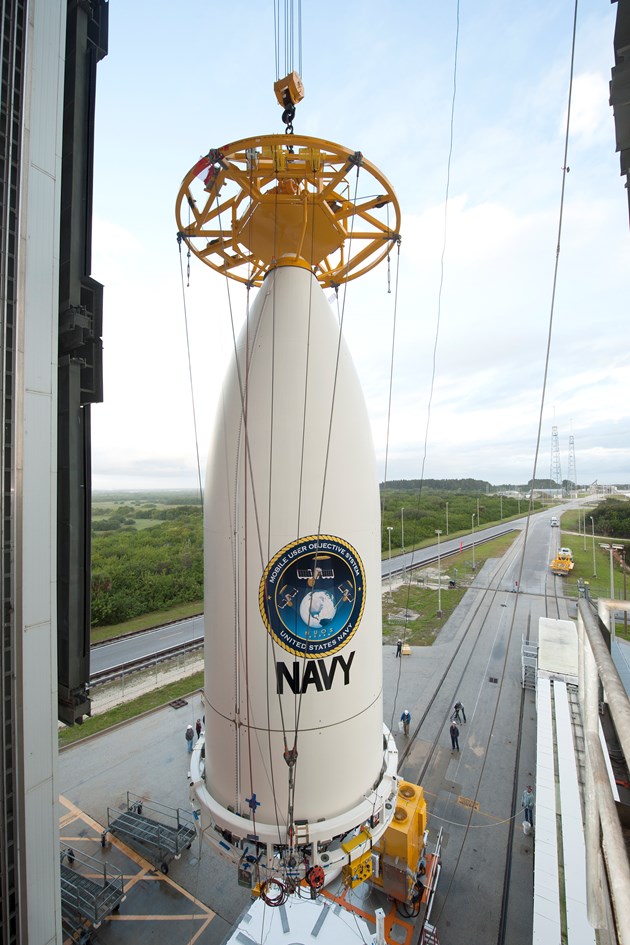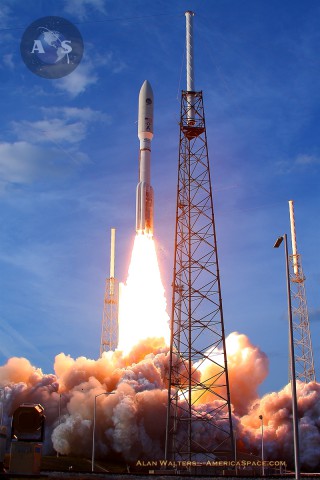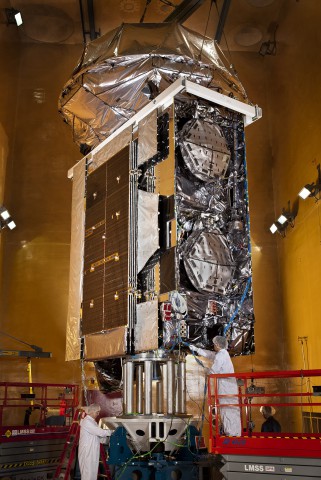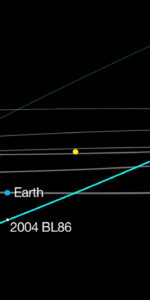
After completing a banner 14 flights last year, United Launch Alliance (ULA)—the Centennial, Colo.-based operator of the Atlas V, Delta IV, and Delta II boosters out of Cape Canaveral Air Force Station, Fla., and Vandenberg Air Force Base, Calif.—will kick off an ambitious 2015 with its inaugural launch on the evening of Tuesday, 20 January. The mission will deliver the third heavyweight Multi-User Objective System (MUOS-3) satellite into geostationary transfer orbit, with an apogee of 22,240 miles (35,790 km), on behalf of the U.S. Navy. Following on the heels of the launches of MUOS-1 in February 2012 and MUOS-2 in July 2013, the 15,000-pound (6,800-kg) MUOS-3 represents the third of an eventual constellation of five next-generation narrowband tactical satellites to offer U.S. and allied military forces improved communications capabilities whilst on the move.
Current plans call for ULA’s venerable Atlas V rocket—flying for only the fifth occasion in its most powerful configuration, the “551,” equipped with a 5.4-meter (17.7-foot) payload fairing, five solid-fueled boosters, and a single-engine Centaur upper stage—to lift off from Space Launch Complex (SLC)-41 at Cape Canaveral Air Force Station, no sooner than 7:43 p.m. EST Tuesday, at the opening of a 44-minute “window.” Capable of delivering up to 41,480 pounds (18,814 kg) to low-Earth orbit and up to 19,620 pounds (8,900 kg) to geostationary transfer orbit, the 551 heavylifter has been used previously to deliver MUOS-1 in February 2012 and MUOS-2 in July 2013, as well as NASA’s Pluto-bound New Horizons spacecraft in January 2006 and the Juno orbiter to Jupiter in August 2011. With MUOS-4 targeted to fly in August, 2015 promises to be the first time that a pair of Atlas V 551s will have launched within the span of a single calendar year.
Launch will get underway at T-2.7 seconds, with the ignition of the Russian-built RD-180 first-stage engine, which burns liquid oxygen and a highly refined form of rocket-grade kerosene (known as “RP-1”) and generates 860,000 pounds (390,000 kg) of propulsive yield. The five Aerojet-built solid-fueled boosters, each measuring 67 feet (20.4 meters) tall, will also ignite and produce a total thrust of 1.7 million pounds (790,000 kg) to supplement the initial boost away from Florida. Climb-out of the 206-foot-tall (62.8-meter) stack from SLC-41 will commence at T+1.1 seconds, beginning an apparently slow ascent to about 85 feet (25.9 meters), after which the avionics of the Centaur upper stage will command a pitch, roll, and yaw program maneuver to establish the Atlas onto the proper flight azimuth of 94.58 degrees in order to deliver the MUOS-3 payload into orbit.

Fifty-one seconds into the flight, the vehicle will pass through a period of maximum aerodynamic turbulence—colloquially known as “Max Q”—and the rapidly ascending stack will throttle down its RD-180 engine and begin a nominal zero-pitch and zero-yaw angle of attack to minimize these loads. At T+110.7 seconds, now exhausted, two of the strap-on boosters will be jettisoned, followed by the others about 1.5 seconds later. A little over 3.5 minutes into the mission, with the RD-180 still burning hot and hard, the bulbous payload fairing will be discarded, and when the 551 reaches a peak load of 4.6 G the engine will be throttled back to maintain this level.
Shutdown is scheduled to take place at T+267.6 seconds, after which the 41.5-foot-long (12.6-meter) Centaur and its attached MUOS-3 payload will separate. To support the delivery of the satellite into its correct orbital “slot,” the Centaur will perform three lengthy firings of its 23,900-pound-thrust (10,840-kg) RL-10C engine. First trialed during last month’s NROL-35 mission for the National Reconnaissance Office, the liquid oxygen/hydrogen-fueled RL-10C measures 7 feet (2.2 meters) long and 4.5 feet (1.4 meters) in diameter and has a dry mass of 420 pounds (190 kg). Although its overall thrust is slightly higher than the 22,300 pounds (10,100 kg) of the earlier RL-10A, the upgraded engine’s specific impulse is a little lower than its counterpart.
The first burn will last almost eight minutes, kicking off at T+283.6 seconds and terminating at T+750.4 seconds. The Centaur/MUOS-3 combo will then coast for a further eight minutes, before the RL-10C ignites for its second burn at 20 minutes and 32 seconds into the mission. This firing is scheduled to run for just under six minutes, steering the payload stack into an intermediate transfer orbit, and will be followed by a substantially longer period of coasting—more than two hours—before the third and final burn gets underway at T+2 hours and 48 minutes. This burn will last about 59 seconds and will deliver MUOS-3 into the Spacecraft Separation Transfer Orbit. When the Centaur’s targeted orbital parameters are achieved, Main Engine Cutoff (MECO) will be initiated by guidance command and the satellite will separate from the upper stage about two hours and 53 minutes after leaving Cape Canaveral Air Force Station. Nominal insertion orbit will be at an apogee of 22,240 miles (35,790 km) and a perigee of 2,370 miles (3,820 km), inclined 19.11 degrees to the equator.
Upon reaching its operational location, high above the Atlantic Ocean, MUOS-3 will join its siblings in the provision of global satellite communications narrowband (64 kbits/sec and lower) connectivity for U.S. and allied military forces, with a UHF range from 300 MHz-3 GHz. When fully functional, it will replace the legacy UHF Follow-On (UFO) satellite network—the first of which was launched way back in March 1993—before the latter system reaches the end of its operational lifetime. MUOS provides new capabilities and enhanced mobility, access, capacity, and quality of service, with particular emphasis upon mobile users, such as aerial and maritime platforms, ground vehicles, and dismounted soldiers. It will extend their voice, data, and video communications far beyond the physical lines of sight. By performing in the UHF band, which is lower than conventional cellular networks, MUOS thus provides U.S. and allied warfighters with the tactical ability to communicate in “disadvantaged” environments, including heavily forested areas, where higher-frequency signals would be otherwise impaired. Even troops in buildings with no satellite access are expected to see an increase in communications capability.

Last year, the initial MUOS network demonstrated new capabilities in the Arctic, an area previously beyond the coverage of UHF satellites and growing in interest for transportation and natural resources exploration above 65 degrees North latitude. The satellites successfully provided almost 150 hours of secure data connections and, for the first time, enabled large-scale data transfers of up to 20 megabytes of documents, photographs, and maps in the Arctic during independent tests by Lockheed Martin and throughout the U.S. Navy’s 2014 Ice Exercise (ICEX) and the U.S. Coast Guard’s Arctic Shield 2014. “MUOS is a game-changer in communications for our warfighters and will allow them to have high-fidelity voice communications, networked team calls and data exchange, including video, with anyone connected to a secure terminal around the world,” said Iris Bombelyn, vice president of Narrowband Communications at Lockheed Martin. “The launch of MUOS-3 will increase our network coverage to about three-quarters of the globe.”
The original contract between Lockheed Martin and the U.S. Navy’s Communications Satellite Program Office was announced in September 2004, extending for seven years and valued at $2.1 billion, for a two-satellite Initial Operational Capability (IOC). That contract has since been extended and present schedules envisage the launch of MUOS-4—which concluded its own environmental testing phase last month—in August 2015 and MUOS-5 in 2016, all utilizing the Atlas V 551 heavylifter. This will produce a constellation of four “operational assets and one on-orbit spare.”
MUOS-3 completed its final stage of thermal vacuum testing in the Dual-Entry Large Thermal Altitude chamber at Lockheed Martin’s Sunnyvale, Calif., facility, in July 2014, and the satellite was transported to Cape Canaveral Air Force Station, by means of an Air Force C-5 Galaxy strategic airlifter, in November. Upon arrival and unpacking, MUOS-3’s propulsion system was fueled by Lockheed Martin engineers, and the satellite was encapsulated in its payload fairing on 18 December.
Meanwhile, the processing of the Atlas V 551 vehicle culminated in a successful Launch Readiness Review (LRR) on Friday, 16 January, allowing teams to press ahead with an opening launch attempt Tuesday evening. Rollout of the stack atop its Mobile Launch Platform (MLP) from the Vertical Integration Facility (VIF) to the pad is scheduled for today (Monday), with high-pressure conditions and favorable weather expected in Florida. Breezy weather is not expected to interfere with the planning and execution of the rollout. After reaching SLC-41, the Atlas V will be carefully centered and propellant umbilicals and electrical and data links will be connected. The track mobiles will then be removed, as ULA prepare for formal countdown operations.
“On Launch Day, high pressure migrates east of the peninsula in advance of the next upper-level disturbance approaching the peninsula with increasing clouds in the mid and upper levels and isolated showers,” the 45th Weather Squadron at Patrick Air Force Base reported Friday, 16 January. “There is a low threat of an isolated thunderstorm. Concerning solar weather, there is a low threat of elevated proton flux through the launch opportunities.” Primary factors which might threaten a scrub are the Thick Cloud Rule, which poses a 40 percent risk Tuesday and a 30 percent risk for the backup launch date (Wednesday).
Want to keep up-to-date with all things space? Be sure to “Like” AmericaSpace on Facebook and follow us on Twitter: @AmericaSpace
Missions » MUOS » Muos-1 » Missions » MUOS » Missions » MUOS » MUOS-2 » Missions » MUOS » MUOS-3 »



